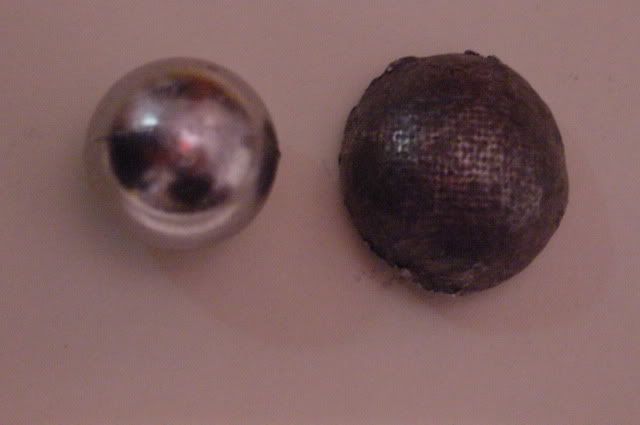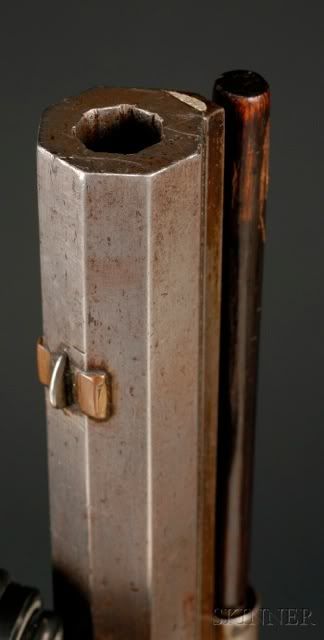That is good news. And not all that uncommon, especially with factory made barrels. Custom or small shop barrels usually have some lapping done before shipment to take the machining roughies off the edges of the lands.
-
Friends, our 2nd Amendment rights are always under attack and the NRA has been a constant for decades in helping fight that fight.
We have partnered with the NRA to offer you a discount on membership and Muzzleloading Forum gets a small percentage too of each membership, so you are supporting both the NRA and us.
Use this link to sign up please; https://membership.nra.org/recruiters/join/XR045103
You are using an out of date browser. It may not display this or other websites correctly.
You should upgrade or use an alternative browser.
You should upgrade or use an alternative browser.
Blown Patches
- Thread starter ScottGustaveson
- Start date

Help Support Muzzleloading Forum:
This site may earn a commission from merchant affiliate
links, including eBay, Amazon, and others.
Greenmtnboy
62 Cal.
- Joined
- Dec 10, 2005
- Messages
- 2,582
- Reaction score
- 12
try wet lube or swab between shot when using a natural lube.ScottG said:I've been reading the posts for a while now. Their knowledge humbles me. I have been shooting muzzleloaders on and off for over 25 years now, but it's been a long time since I've built one from a kit. New barrel, new problems, but they have all happened to others before.
Im hoping someone will post an idea I just have just forgotten about.
If it's hot out or your barrel gets hot .015 patches are easy to blow.
- Joined
- Jan 3, 2004
- Messages
- 14,767
- Reaction score
- 319
Greenmtnboy said:If it's hot out or your barrel gets hot .015 patches are easy to blow.
Aha! Something more for me to think about. I've had patches suddenly start blowing late in a shooting session, using a combo that otherwise never blows. Never thought of heat as a factor, but it's something for me to test.
Thanks!
BTW- I'm using .018 ticking, but as a general rule my combos are pretty easy to seat. :hmm:
Just my thoughts but I don't think heat would be enough to change a barrel size enough to talk about.
If a 12 guage barrel (.729) was heated 200 degrees F over the ambient air temperature the bore size would increase .0010.
Using normal measuring standards, that barrel would be 270 degrees F.
More practically speaking, if the barrel got to be 170 degrees F in the heat of the noon day sun plus shooting it would grow .0005 (one half of one thousandth of an inch).
That growth would only change the squeeze or pinch on the patch .00025.
Heat will effect the patch lube and that can make a noticeable difference though.
If a 12 guage barrel (.729) was heated 200 degrees F over the ambient air temperature the bore size would increase .0010.
Using normal measuring standards, that barrel would be 270 degrees F.
More practically speaking, if the barrel got to be 170 degrees F in the heat of the noon day sun plus shooting it would grow .0005 (one half of one thousandth of an inch).
That growth would only change the squeeze or pinch on the patch .00025.
Heat will effect the patch lube and that can make a noticeable difference though.
- Joined
- Jan 3, 2004
- Messages
- 14,767
- Reaction score
- 319
Zonie said:Heat will effect the patch lube and that can make a noticeable difference though.
That's all I thought of, but thanks for the details on the metallurgy, too.
cynthialee said:Dan,
Of all the things you list that can be a cause of blown patches they all make sense except where you mention that too light of a powder charge can cause blown patches.
How does that work?
thanks for the information provided, it is apreciated

This is my theory.
The powder does not all burn at once and it can work as a gasket during initial acceleration.
I can see no other reason for increasing the load helping with patch blowing which I have read and been told it can do. It might cause faster initial acceleration and cause the ball to upset somewhat. I think its possible for the ball to increase slightly in diameter as it starts to move. I have flip-flopped on this for years. BPCR bullets especially the heavy ones will upset a great deal and they do it while still in the cartridge case. The back of the bullet moves before the front. This can cause serious, accuracy destroying deformation if the bullet design is bad and the bullet too soft. The blunt bullets like the Sharps hunting bullets and the Gov't bullets for 45-70 were immune to this. The match bullets with long or multiple radius ogives were very hard alloys in most cases but the base would still upset to fill the bore. Many Sharps 45 cal barrels were .010-.015 over nominal bullet diameter even the target versions.
If a bullet will upset easily .010 at a alloy of 1:20 (standard alloy for even the hunting bullet in 40 cal) why would a lead RB not? But I have never seen any evidence of this.
I wish Lyman had published more HS photos of RBs in flight in their Blackpower Handbook. My first edition has only Mine-balls and a double ball load which explains nothing of interest on our topic here.
If you shoot a BP cartridge rifle with no over powder wad you will see pretty significant powder grain imprints on the bullet base. The RB lacks the inertia and the patch pads it so you do not see this in the RB though you may see a definite patch imprint as on this .662 ball used with heavy ticking and FFg Swiss.

There are other factors to consider too.
The rifle that uses the .662 ball has a Nock Breech which should burn the powder faster. This rifle is loaded pretty tight. It has 8 wide .008 grooves. It loads easy and never blows patches with ticking or slightly thinner linen.
As Dutch Schoultz as mentioned, aside from some problem like a poorly cut crown or burrs on the rifling blown patches are a fit issue or possibly a lube issue.
I have some heavier denim I intend to try in the swivel breech but its really tight and I will need to make a starter with a larger knob for this stuff.
Rifles can be very individualistic as well.
What surprises me is that a great many original rifles, in the 19th cent at least, were choked and were thus loose at the breech. Typically a very slight "relief" at the muzzle to a choke perhaps 2-4" down then a taper enlarging toward the breech. Many of these rifles have rifling forms very much like modern lands and grooves too.

That these choked barrels shoot very well and load easy seems to disagree with the tight fit to keep patches whole. These barrels are loosest at the point of initial acceleration and highest pressure.
So????
All this stuff may cause more "but how comes?" than answers.
While I sometimes think people shoot too little powder the opposite must be avoided as well especially with some of the guns/components on the market. To much can also cause problems either with the patch or with the mechanics of the firearm. Hammers blown back to 1/2 or nipples blown out (this can happen as a result of poor design too) are just two of these.
Most rifles will shoot best somewhere in 45-50% of ball weight powder. Smaller bores like 32 may need 60-70%, larger bores may only need 30% or a little more. I shoot about 32% of ball weight in my 15 bore rifle (.662 ball) but this is still 140 grains and produces abut 1600 fps. I do believe based on other rifles that the lower charge ratio makes for softer fouling. But in a 50 the velocity will be too low for hunting and likely the accuracy will be poor.
The bottom line is that people must do the experimentation and find what works in their rifle.
While there is valuable advice on site such as this it still has to be translated into results with the individual rifle.
Dan
ScottGustaveson
32 Cal.
- Joined
- Jun 30, 2012
- Messages
- 21
- Reaction score
- 0
Thought I'd give another update. I Shot today and after my first shot I began to notice some small holes in my patches. Puzzled, I shot another three shots with 90g of powder. the holes were much worse.
I was pretty happy before and kind of figured the sharp spots would shoot themselves out, so I just kept shooting, but I was was upset again when shooting the heavier hunting loads. I remembered a member saying he liked running just a spit patch between loads. I tried it and holy cow, no cuts, nothing, even at 90g. Another two hours of shooting and still perfect. My groups settled down and I started shooting bullseyes.
I just wanted to let everyone know for future reference.
I was pretty happy before and kind of figured the sharp spots would shoot themselves out, so I just kept shooting, but I was was upset again when shooting the heavier hunting loads. I remembered a member saying he liked running just a spit patch between loads. I tried it and holy cow, no cuts, nothing, even at 90g. Another two hours of shooting and still perfect. My groups settled down and I started shooting bullseyes.
I just wanted to let everyone know for future reference.
Similar threads
- Replies
- 51
- Views
- 3K




